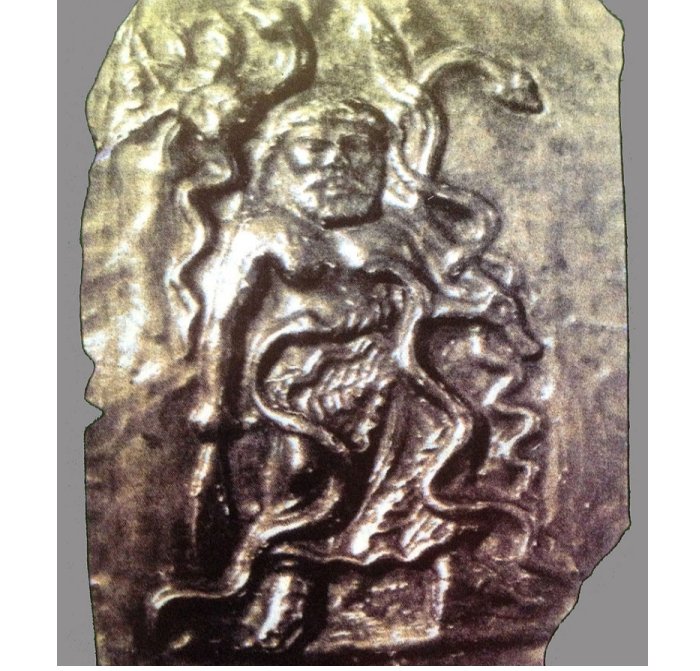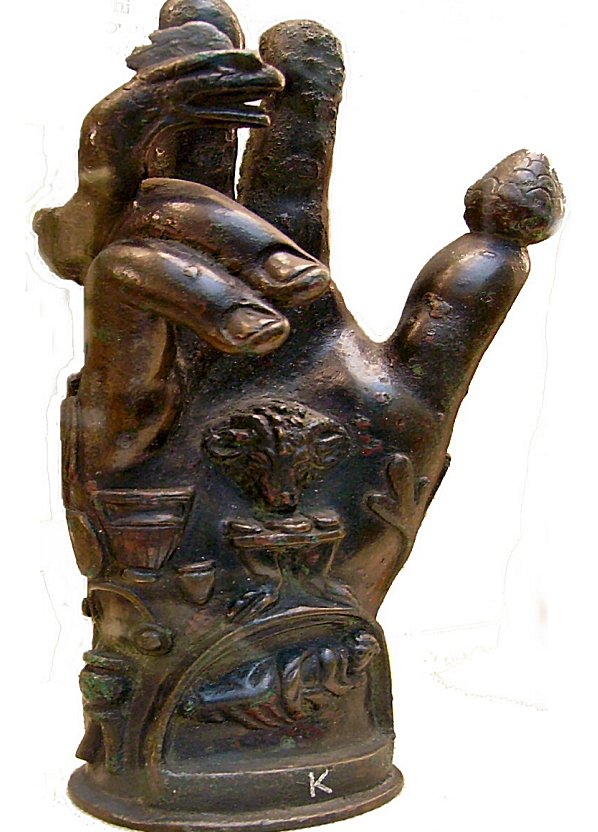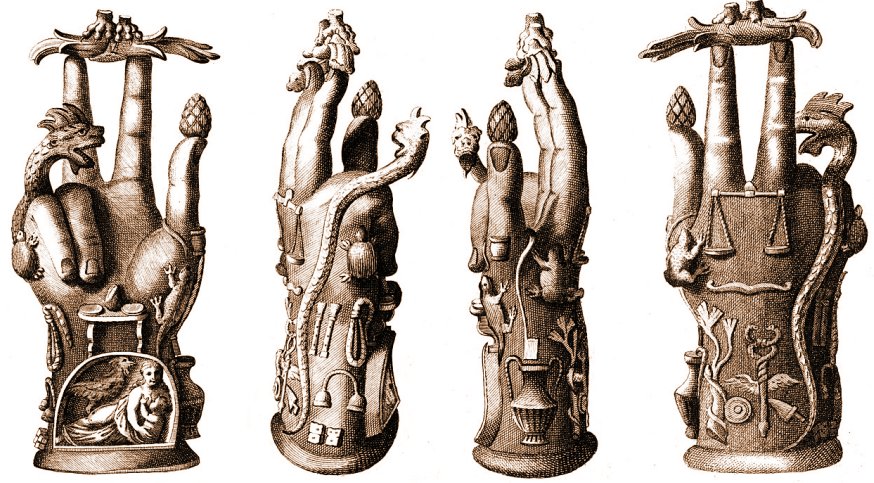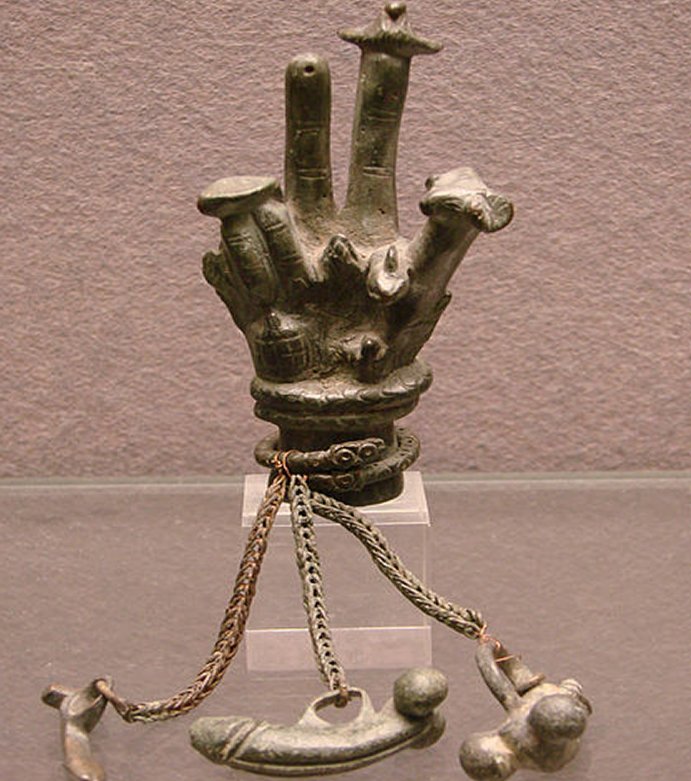A. Sutherland – AncientPages.com – The Thraco-Phrygian deity, known as Sabazius, has been frequently identified with Dionysus.
He had a small yet persistent presence in the Roman Empire and Greece.

Silver votive plaque with an image of Sabazios with snakes (find from Belintash, the Rhodope Mountains, Bulgaria 6th-5th century BC. Image credit: Kmrakmra – CC BY-SA 3.0
It seems, however, that this god was also revered in some other places in ancient Europe.
Sabazius – Unwillingly Tolerated Deity
Sabazius (Sabazios) was a “Phrygian and Thracian savior-god whose cult spread throughout the Mediterranean during the classical and Hellenistic period.
He was unwillingly tolerated at Athens as a newcomer and received much the same treatment in Rome, though never attaining the notoriety of his more popular Phrygian relative – Cybele.” 1
In other words, Sabazius was not among the most popular deities of the ancient world but was generally accepted as a deity of fertility and vegetation and worshipped with Zeus and Dionysus, the god of wine. It is said that Sabazius was the sky-father god in the beliefs of the Phrygians.
Later, the Thracians considered him (like Dionysus) as one of the incarnations of an extremely popular deity called Heros (a Thracian rider), who, in Thracian beliefs, means all male deities have the characteristics of horse hunters. In Rome, Sabazius was linked to the god Jupiter.
Sabazius’s worshipers honored him with a hand, but not an ordinary one.
Perplexing Hand With Symbols ᴀssociated With Sabazius
The right hand, ᴀssociated with Sabazius, is decorated with many religious symbols and others of great significance.

Bronze hand used in the worship of god Sabazios. British Museum. Source – Public Domain
As we know, a human hand can express many different gestures. This hand, carved in ‘benediction Latina gesture,’ (means’ hand of benediction and blessing) seems to have had ritual importance in sanctuaries of the religious people of Rome, Athens, and even in places like Herculaneum and in the region of a 2,000year-old market town, near the crossroads of a Roman road, now modern Tournai, Belgium.
It is believed that these full of secrets, bronze-alloy hands, were usually used in religious processions.
Although there are many variations, the hand of Sabazius is typically depicted with a serpent or pair of serpents encircling the wrist and surmounting the bent ring and pinky fingers.
Another symbol is a pinecone on the thumb, which is an important symbol. It is one of the most mysterious emblems in ancient and modern art and architecture.

Hand of Sabazios – View from various angles. Source – Unknown author – Public Domain
The pine cone symbol meant the highest degree of spiritual illumination possible and was recognized by ancient cultures worldwide. It was unearthed in the ruins of the Indonesians, Babylonians, Egyptians, Greeks, Romans, and Christians, to name a few. It also appears in the drawings of esoteric traditions like Freemasonry, Theosophy, Gnosticism, and Esoteric Christianity.
The pine cone had the same meaning: It symbolized a secret vestigial organ, the “pineal gland” or “Third Eye.”
The Hand of Sabazius was sometimes decorated with additional symbols such as a lightning bolt over the index and middle fingers, a lizard and turtle on the back of the hand, an eagle, a ram, bull, frog, and other animals, who were all companions of Sabazius.
The mysterious hand also has a place for a leafless branch, a wand (thyrsus), ᴀssociated with the Greek god Dionysus, and the so-called ‘Mounted Heros’ reliefs (3rd century BC to the 3rd century AD) of the Hellenistic and Roman periods in Macedonia, Thracia, and Moesia.
Who Was Mysterious God Sabazius?
Now, we see that Sabazius was a deity with many secrets. He was described as a bearded man wearing a Phrygian cap.
Later, the Thracians considered him (like Dionysus) as one of the incarnations of an extremely popular deity called Heros (otherwise Thracian rider), reflecting their religious belief that all male gods have the characteristics of horse hunters.

A hand used in the worship of Sabazius. Image credit:
According to Eugene N. Lane, only a few inscribed reliefs contain a picture of Sabazius and his name. Much discussed is one relief from Lydia, with an “inscription commemorating an introduction of the cult of Zeus Sabazius in 101 AD.
Sabazius is shown in a chariot, bearded. Above the two horses which draw the chariot is an eagle, and below them a snake. Behind the horses is an accompanying figure, probably intended for Hermes, holding a caduceus, and there is a crescent moon near him.
“… Sabazius is a bearded figure standing at an altar and making a libation. Both the sure and the hypothetical Sabazius figures are heavily draped. In the lower register of the relief is an altar with a tree behind it amid a group of votaries.… Vi can summarize as follows: Sabazius can be shown seated, on horseback, or in a chariot.” 2
Other attributes include a spear or scepter, a patera, a thunderbolt, and a crater.
During the Hellenistic period and the Roman Empire, he was identified with many deities, nicknamed Hypsistos (literally: “Supreme”). There is no known myth dedicated to him.
Worshiping of Sabazios included ecstatic dances, mystical formulas, and probably even extreme bodily pleasures. The worship of Sabazius had a bad reputation among the educated Greeks.
Written by – A. Sutherland – AncientPages.com Senior Staff Writer
Copyright © AncientPages.com All rights reserved. This material may not be published, broadcast, rewritten or redistributed in whole or part without the express written permission of AncientPages.com
Expand for references
- Lowe, Dunstan. “Sabazius in the Aeneid (7.341-60).” Vergilius (1959-)58 (2012): 81-91Lane,
- Eugene N. Lane, “Towards a Definition of the Iconography of Sabazius.” Numen 27, no. 1 (1980): 9-33
John Hopkins – Archaeological Museum





